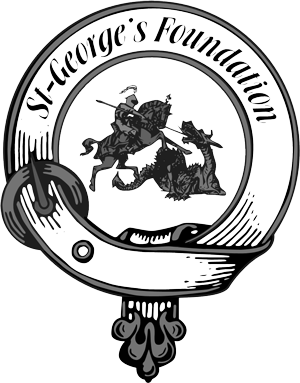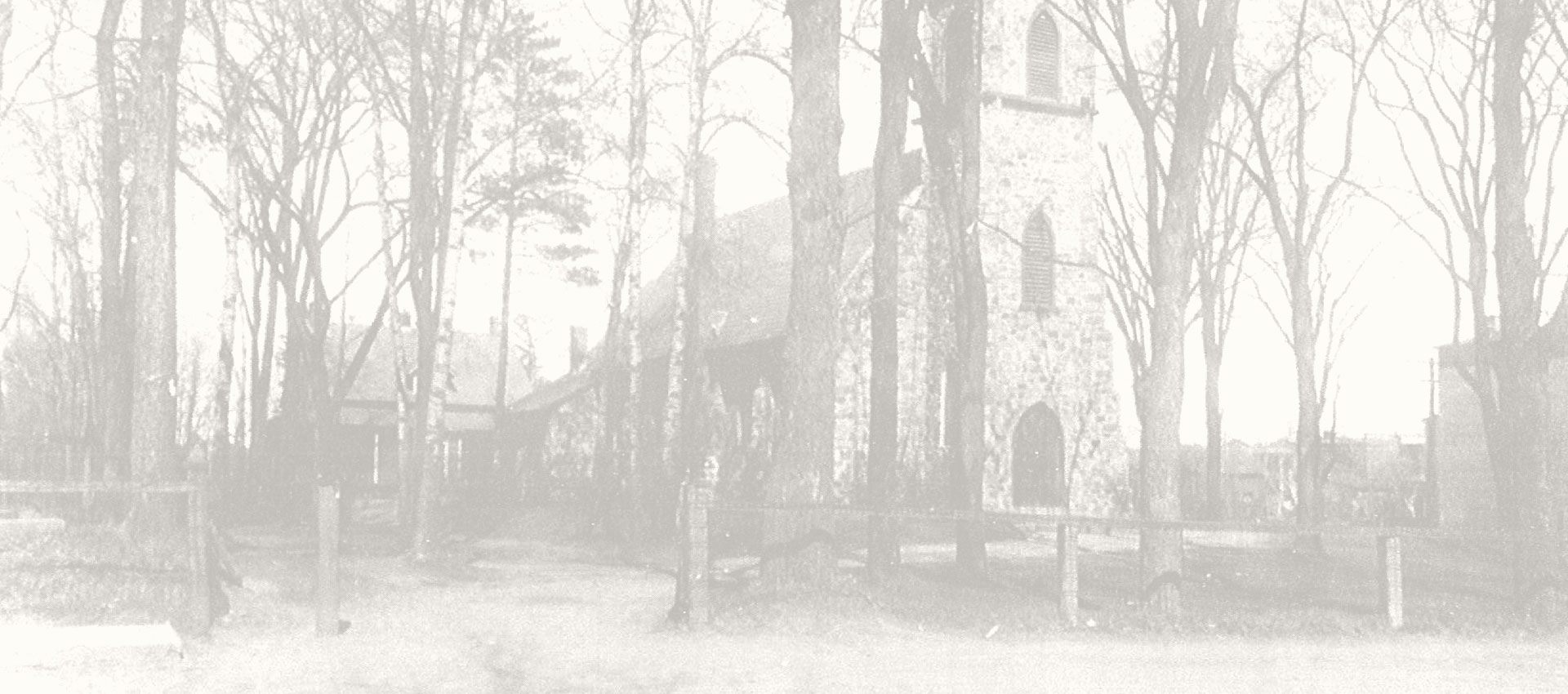
History
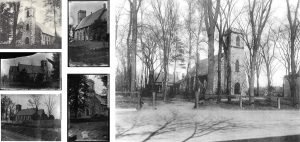 St. George’s Anglican Church sits on the highest plateau in old Drummondville, well off Heriot Street, the first street laid out by the Founder, Major-General Frederick George Heriot. This location in relation to the street conveys a mysterious yet pleasant charm amplified by the many century old trees under which early settlers and the founder could rest. The construction materials, stone for the walls and slate for the roof, the bell tower pierced by portals of mahogany and the hanging arches are elements that testify to the concern of the Church of England to bring to its colonies places of worships that are spacious and uplifting that demonstrate its prestige and pride of its communities who had them built.
St. George’s Anglican Church sits on the highest plateau in old Drummondville, well off Heriot Street, the first street laid out by the Founder, Major-General Frederick George Heriot. This location in relation to the street conveys a mysterious yet pleasant charm amplified by the many century old trees under which early settlers and the founder could rest. The construction materials, stone for the walls and slate for the roof, the bell tower pierced by portals of mahogany and the hanging arches are elements that testify to the concern of the Church of England to bring to its colonies places of worships that are spacious and uplifting that demonstrate its prestige and pride of its communities who had them built.
The interior boasts remarkable stained glass windows which are stained in red and blue with ash panelling, elaborate woodwork and many memorials, either in brass or marble and sacred vases engraved in the memory of brave parishioners and generous donors. St. George’s Church is an eloquent milestone in the history of the first century of the existence of Drummondville founded and led by immigrants wishing to establish their descendents on land for the future according to British habits and customs and the rules of the Church of England.
Settlers of British origin
 Drummondville was founded by Frederick George Heriot, a young officer in the British army who participated in the War of 1812 in which the Americans had tried to invade Canada. Officer of the Voltigeurs de Salaberry, Heriot especially distinguished himself at the battle of Chrysler’s Farm (current site of Upper Canada Village). He was promoted to Lieutenant-Colonel in 1813 1.
Drummondville was founded by Frederick George Heriot, a young officer in the British army who participated in the War of 1812 in which the Americans had tried to invade Canada. Officer of the Voltigeurs de Salaberry, Heriot especially distinguished himself at the battle of Chrysler’s Farm (current site of Upper Canada Village). He was promoted to Lieutenant-Colonel in 1813 1.
At the head of 50 demobilized soldiers from the Voltigeurs, Wattevile and Meurons regiments, Heriot, 29 years old, left Fort William Henry (Sorel) to go up the St. Francis River and found Drummondville on July 26, 1815. Heriot would be the official distributor of the land to demilitarized British soldiers and immigrants for the new settlement on the St. Francis River. His colonization efforts are supported by a vast promotional campaign by the British Government to attract potential immigrants to Upper and Lower Canada 2..
The Church of England
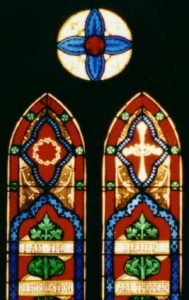 Gordon Drummond 3. administrator of the Canadas in 1815, recommends the building of a church in Drummondville (the latter named in his honour) and suggests that a military chaplain be sent from Fort William Henry to exercise his ministry and establish a permanent residence. Because, Drummond believed, the preaching of the Gospel brings prosperity and happiness to the poor people. His request is accepted because on March 14, 1816, Joseph Langley Mills, Protestant Chaplain of His Majesty’s forces, visits Drummondville 4..
Gordon Drummond 3. administrator of the Canadas in 1815, recommends the building of a church in Drummondville (the latter named in his honour) and suggests that a military chaplain be sent from Fort William Henry to exercise his ministry and establish a permanent residence. Because, Drummond believed, the preaching of the Gospel brings prosperity and happiness to the poor people. His request is accepted because on March 14, 1816, Joseph Langley Mills, Protestant Chaplain of His Majesty’s forces, visits Drummondville 4..
Until 1832 the pastor of St. George’s Church serves Anglicans of the townships of Grantham, Wickham, Durham, Kingsey, Simpson, Wendover, Shipton and Melbourne, as well as immigrants scattered in the seigneuries of Courval, Rivière-Davis and Baie-du-Febvre. There are 882 Anglicans in 1831 and, ten years later, there are 1270. The missionary must travel over 50 km on horseback, on foot, by canoe…to reach his flock who are claiming the sacraments and his preaching.
Anglicans and Catholics share the same cultural space
 In the fall of 1817, chaplain Jackson celebrates the opening of a chapel in Drummondville and, at the same time, Anglicans entrust a number of books donated by the Society for the Propagation of the Gospel in Foreign Parts 5.. Jackson noted the progress of the chapel through a donation of £100 from the government 6..
In the fall of 1817, chaplain Jackson celebrates the opening of a chapel in Drummondville and, at the same time, Anglicans entrust a number of books donated by the Society for the Propagation of the Gospel in Foreign Parts 5.. Jackson noted the progress of the chapel through a donation of £100 from the government 6..
In fact, the celebration took place in a barracks located on the «place d’armes». Heriot and his men had built, upon their arrival, three barracks to store all the necessities (food and tools) as well as their weapons. Hence the name «place d’armes» for the area south of Wood lane.
As it must be practical, the same barracks serves as a school, Court of Justice and place of worship for Anglicans and Catholics 7.. For its part, Heriot’s residence, known as Comfort Cottage, welcomes the Anglican chaplain and Catholic missionary, Anglican 8. Bishop Mountain 9. and Catholic Bishop Plessis while they tour the Eastern Townships. Not at the same time, however, even though they do get along.
Distinct Churches
 Heriot wants to see the continuation of this cohabitation, but Mountain and Plessis demand separate buildings for the two religions 10.. In 1821, Heriot gives three lots of 66′ x 132′ to the Protestants in the upper town. On May 10, 1822, Governor General Lord Dalhousie, signs the letters patent formally establishing the Anglican Parish of Drummondville 11.. On July 9, 1822, Reverend Wood informs Bishop Mountain that the stone foundation had been raised and the land had been levelled 12..
Heriot wants to see the continuation of this cohabitation, but Mountain and Plessis demand separate buildings for the two religions 10.. In 1821, Heriot gives three lots of 66′ x 132′ to the Protestants in the upper town. On May 10, 1822, Governor General Lord Dalhousie, signs the letters patent formally establishing the Anglican Parish of Drummondville 11.. On July 9, 1822, Reverend Wood informs Bishop Mountain that the stone foundation had been raised and the land had been levelled 12..
Opened for worship in 1822, the modest church is pierced with a few windows and its exterior walls are clad in wood. The costs had been borne by the Society for Promoting Christian Knowledge 13., a missionary society based in London that promotes the establishment of the Church of England in the colonies by contributing financially to the construction of churches.
During his visit in 1829, Bishop Mountain criticizes Reverend Wood for the harshness of his church. Its windows are square, there is no bell tower and the paneling is unpainted. It is impossible not to wish that the House of God should bespeak reverence in its exterior, & exhibit its proper distinctions to the eye 14.. In 1833, a bell tower is erected on the west face, in which a bell, donated by Heriot, is suspended. The nave is furnished with 18 pews, of which 10 are rented while five long pews are free available to less fortunate parishioners 15..
Heriot wishes that the two Churches, Anglican and Catholic, be under the name of St. George. Bishop Plessis does not agree and, at the risk of angering Heriot, chooses Saint Frederic for the name of the Catholic Church 16..
The Influence of the Ecclesiologists
 Towards the end of the first half of the 19th century, a group from the Church of England is committed to restore medieval traditions not only in England, but throughout the British Empire. Known as ecclesiologists, they redraw the face of Anglican worship in the gothic style of the 13th and 14th centuries which they consider as the appropriate style that pushes towards the heavens and is full of Christian symbols 17..
Towards the end of the first half of the 19th century, a group from the Church of England is committed to restore medieval traditions not only in England, but throughout the British Empire. Known as ecclesiologists, they redraw the face of Anglican worship in the gothic style of the 13th and 14th centuries which they consider as the appropriate style that pushes towards the heavens and is full of Christian symbols 17..
Bishop Mountain knows the ecclesiologist movement, but realizes that the architectural features are much too costly for the congregations of Lower Canada. In 1851, in the Canadian Ecclesiastical Gazette, he publishes a guide that allows for the adoption of proposed changes 18.. Architecturally, the ecclesiastical symbols are based on eight points:
1. The Church must be instantly recognized as being the House of God. i.e. Gothic by way of hanging arches and buttresses (real or false) that run the length of the building;
2. The favoured material is stone; brick is considered an inferior material and wood to be used in the event of force majeure;
3. The sanctuary is oriented east19 with three lancet windows to symbolize the Trinity.
4. Placed on a platform, the alter is joined to the sanctuary and closed to the rest of the choir by a rail or communion table.
5. The main entrance is located in the centre of the western wall (or the western side of the south wall) and can be decorated with a porch.
6. The width of the church is one-third of its length.
7. The frame is visible inside, thus prohibiting false ceiling in plaster, flat or vaulted that can introduce a false element in a Church.
8. A vestry is built at the northeast side of the choir to prevent members of the clergy from dressing into their vestments in view of the attendees.
With regards to furniture and landscaping, the recommendations are summarize in five points:
1. Sufficiently large for the complete immersion of the child, baptismal fonts are installed near the entrance to remind the faithful of their own entry in the spiritual Church;
2. The pulpit is located on the north side of the nave to view the choir where care will be taken to place two bookstands, one for the bible and the other for the prayer books;
3. The pews in the nave are not closed by doors. In additional, they are free;
4. The sanctuary floor (between the chancel and the communion table) is covered in carpet;
5. The alter is always covered by an alter hanging (cloth) which reaches the ground;
St. George’s Church built in 1855.
 Robert Nugent Watts, cousin and Heriot’s heir who died on December 29, 1843, gives the land on which the Church is to be built. It is adjacent to the cemetery, on the south side. Other members of the community provide materials or time.
Robert Nugent Watts, cousin and Heriot’s heir who died on December 29, 1843, gives the land on which the Church is to be built. It is adjacent to the cemetery, on the south side. Other members of the community provide materials or time.
In 1855, the foundations are laid for the new Church which will hold 180 people. A Church measuring 23 metres (choir and nave) by 7 metres (interior of the walls) 20., excluding the portico and the vestry. Whereas the walls are 5 metres high in the interior. The cornerstone from the previous Church is set on June 10 (1855) on the new building giving the false impression that that it was built in 1820.
The man responsible for the project and who guided the parish for 27 years, the Rev. George McLeod Ross died a few months later, at the age of 51. The distraught parishioners install a stained glass memorial window ‘The Tree of Life’ to forever celebrate the life of their much loved Minister 21.. A second memorial window named ‘Window of the Evangelists’ is donated by the descendants of Major Menzies and his wife born Helen Stewart.
The Fire of 1863
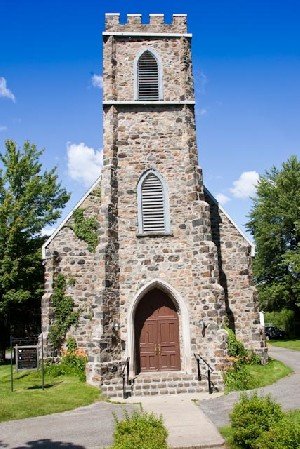 During the night of May 4, 1863, a fire engulfs St. George’s Church sparing only its stone walls and two stained glass windows 22.. The test is all the more heavy as there is no minister in position at the time of the fire and the debt incurred in 1855 for the construction of the Church has not yet been eliminated. A committee of lay people is set up to deal with the emergencies.
During the night of May 4, 1863, a fire engulfs St. George’s Church sparing only its stone walls and two stained glass windows 22.. The test is all the more heavy as there is no minister in position at the time of the fire and the debt incurred in 1855 for the construction of the Church has not yet been eliminated. A committee of lay people is set up to deal with the emergencies.
On the charred stone walls, a cedar shingle roof is installed and a bell tower is constructed which also serves as a portico. A solid oak door is donated by Miss Sheppard as well as the bell for the bell tower. The two stained glass windows that survived the flames are restored and the stained glass windows for the sanctuary as well as simple glass windows for the openings in the nave 24. were purchased from the Spence Company 23. of Montreal. The restored St. George’s Church is dedicated in 1867 by Bishop J.W. Williams 25..
Finances in constant flux
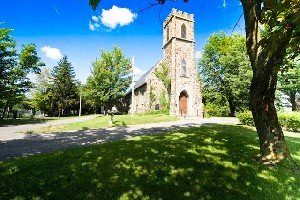 During the 1880’s, while the McDougall Foundry was producing at full capacity, the members of the Anglican community are more numerous and more prosperous. Strengthened by the new resources, Rev. Allnatt undertakes the construction of a rectory within the Church property and carries out significant work to first make the Church more comfortable and more gracious in some respects, such as:
During the 1880’s, while the McDougall Foundry was producing at full capacity, the members of the Anglican community are more numerous and more prosperous. Strengthened by the new resources, Rev. Allnatt undertakes the construction of a rectory within the Church property and carries out significant work to first make the Church more comfortable and more gracious in some respects, such as:
1. A more adequate heating system;
2. Repointing of the masonry;
3. Stone crenels replace the wooden arrows decorating the top of the bell tower;
4. Slate tiles replace the cedar roof shingles;
5. Ash panelling 26 . to provide for a more intimate interior and stop the intrusion of the vine that envelopes the exterior of the Church.
6. A new oak alter with reredos and retable 27 . at the centre on which is placed a brass cross 28.. The alter cloths and hangings are ordered from the St. Matthews Guild in Québec City.
Financial problems once again are a concern for the parish administrators at the turn of the 20th century. And for good reason, as for two decades the number of Anglicans served by the Drummondville parish never exceeds 150.
Regional economic activity improves in the 1920s, as large textile mills are established in Drummondville attracted the hydro electric energy produced by the Lord and Hemming Falls general stations, respectively in operation in 1919 and in 1926. In 30 years, from 1921 to 1951, Drummondville’s population goes from 4,500 to 34,000 inhabitants.
Anglicans recruit worshippers from among the newcomers; professionals, managers and skilled workers, some of whom arriving from England. The maintenance of the grounds and buildings is largely assumed by Canadian Celanese. In 1952, there are 596 Anglicans, a record that has never been matched. Since 1944, a permanent member of the clergy was assigned to the Parish of St. George and is committed to its financial viability.
Centenary Celebrations
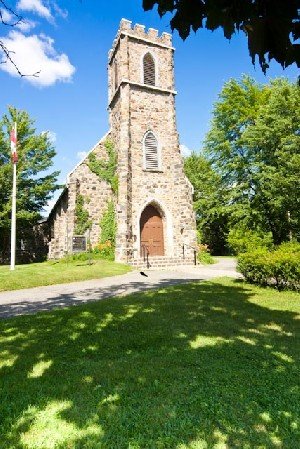 June 22, 1922, the Bishop of Quebec presides over an impressive ceremony at St. George’s Church to mark the 100th anniversary of the founding of the Parish. No effort was spared to beautify the Church and its property:
June 22, 1922, the Bishop of Quebec presides over an impressive ceremony at St. George’s Church to mark the 100th anniversary of the founding of the Parish. No effort was spared to beautify the Church and its property:
1. New lights are installed in the Church;
2. Silver pieces enrich the treasury, such as a collection plate, a paten and cruets;
3. An oak pulpit and lectern is added to the furniture in the nave;
4. The property is levelled, the driveway is gravelled and floral arrangements are planted under the direction of Mr. W.B. Williams of Canadian Gossard Co.;
5. On the flag pole donated by R.S. Fisk, a Union Jack is flown provided by J. Harrison;
6. The outside of the Rectory is repainted 29..
Progress is Ongoing
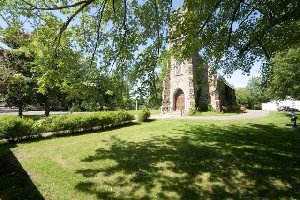 In 1937, the pulpit is relocated further away from the choir to make space for the installation of a new organ purchased from the renowned Casavant Company of St. Hyacinthe 30.. The liturgical renewal of the 1960s requires the relocation of the altar towards the centre of the sanctuary so that the minister faces the faithful during the service. Only the base of the altar is preserved while the rail (communion table) now spans the entire width of the sanctuary. A wrought iron fence closes the choir which is accessed by a small staircase whose ramps have been paid for by the Y.W.A.
In 1937, the pulpit is relocated further away from the choir to make space for the installation of a new organ purchased from the renowned Casavant Company of St. Hyacinthe 30.. The liturgical renewal of the 1960s requires the relocation of the altar towards the centre of the sanctuary so that the minister faces the faithful during the service. Only the base of the altar is preserved while the rail (communion table) now spans the entire width of the sanctuary. A wrought iron fence closes the choir which is accessed by a small staircase whose ramps have been paid for by the Y.W.A.
Towards a Merger
 From the 1950s, Drummondville’s is seriously impacted by the crisis faced by all companies in the Canadian textile industry, especially since the textile sector accounted for 80% of the manufacturing jobs. A turn-around would not be felt until the mid-1980s, owing to the development of SMEs and the emergence of local entrepreneurship. However, Anglicans, from senior and middle management levels in the large manufacturing firms, had already left Drummondville.
From the 1950s, Drummondville’s is seriously impacted by the crisis faced by all companies in the Canadian textile industry, especially since the textile sector accounted for 80% of the manufacturing jobs. A turn-around would not be felt until the mid-1980s, owing to the development of SMEs and the emergence of local entrepreneurship. However, Anglicans, from senior and middle management levels in the large manufacturing firms, had already left Drummondville.
On January 1, 1972, while it has less than 200 parishioners, the community of St. George joins that of St. James (South Durham) and Holy Trinity (Kirkdale) to form the Greater Parish of St. Francis of Assisi. The name is chosen because of the presence of the St. Francis River in all three parishes. In addition, two congregations are mostly composed of farmers and bird-watching is a pastime enjoyed by several parishioners.
A Heritage to Protect
In 1991, a group of Drummondville citizens forms the St. George’s Church Preservation Committee with the purpose of restoring and preserving this historic site for posterity. Less than two years later, the Committee creates a registered non-profit corporation, which is the St. George’s Church Foundation Inc. The Foundation initiates various reports, costs estimates and establishes priorities based on the urgency, however, without significantly affecting the use or vocation of the site.
In 1998, phase 1 of the major projects realizes the restoration of the exterior of the Church: the stone walls in their entirety and the bell tower are repointed, natural stone poured concrete on the window sills and a mahogany door replaces the oak front door. By regulation, the City of Drummondville cites St, George Church and its adjacent cemetery as a ?Historic Monument?.
Initiated in 2000, phase 2 of the major projects involves the replacement of the asphalt shingles on the roof by slate tiles. In subsequent years, the financial resources will be directed towards the development of the cemetery and the promotion of the entire site.
Other components of the site
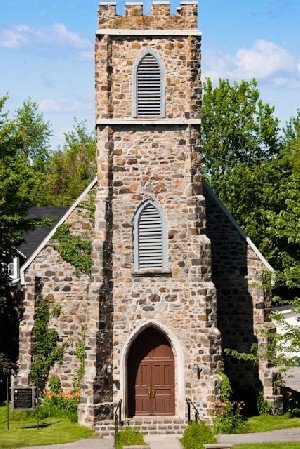 The designers of the St. George’s Church imaged building the Church in a wooden enclosure before the Rectory and Parish Hall. On the northern flank of the Church extends the cemetery where the pioneers and their descendants were buried for more than a century, including Drummondville’s Founder, Major-General Frederick George Heriot.
The designers of the St. George’s Church imaged building the Church in a wooden enclosure before the Rectory and Parish Hall. On the northern flank of the Church extends the cemetery where the pioneers and their descendants were buried for more than a century, including Drummondville’s Founder, Major-General Frederick George Heriot.
The construction of the Rectory which was to follow closely the Church materializes some 20 years later, in 1878-79. It adopted the Quebec style in which the two-slope roof is pierced by a dormer gable. The outer envelope of the Rectory has undergone many alterations since its construction: the cedar roof shingles have been replaced by asphalt shingles, the wood siding by asbestos shingles and the long gallery by a portico.
In the southeast corner on the property, between the railway and the Rectory, is the Church Hall, destined to accommodate various Church and leisure activities, as well as Parish service club meetings. It is a recycled building donated by the Southern Canada Power Company in 1926 31.. The Hall was expanded by 3.5 metres in 1935 32..
Fenced since 1822 and consecrated in 1846, the St. George cemetery had also housed the first Church of the same name, which was a modest wooden structure demolished around 1856. This sacred garden was planned informally. Thus evidenced by its hilly topography and its winding central pathway that swings according to the whims of the land or to work its way around a large tree. Added to these picturesque, disparate headstones by their form, their template and their patina differentiated according to whether they are slate, marble, limestone or iron.
Source: Yolande Allard
NOTES
1 Saint-Germain, C. Brief History of Drummondville a short story. Société Historique du Centre du Québec, 1983. p. 3.
2 Bélanger, J.P. Histoire de Drummondville 1815-1950., Société d’histoire de Drummondville, hors série No 1, 1997. non-publié. p. 25.
3 Biographical Dictionary of the Canada, vol. VIII, Sir Gordon Drummond, officer and administrator of the Canadas of 3 April 1815 to May 20, 1816.
4 Saint-Germain, C. Regards sur les commencements de Drummondville. Cahier no 1, Société historique de Drummondville, 1978. p. 16-17.
5 Society for the Propagation of the Gospel in Foreign Parts, missionary work founded in 1701, who pays, among others, the salary of the pastor Wood.
6 J. Jackson letter to Bishop Mountain on November 8, 1817.
7 S.S. Wood to the Lord Bishop of Quebec, Dec. 13, 1819.
8 Ibid, July 18, 1821.
9 The Journal of Archdeacon G.J. Mountain’s visitation of 1829, principally thro’ the Eastern Townships in Journal of Eastern Townships Studies, no 16, Spring 2000. p. 84.
10 Little, J. Bordeland Religion, The emergence of an English-Canadian Identity 1792-1852. Univ. of Toronto Press, 2004.
11 The St. George parish includes the townships of Grantham, Wickham, Durham, Kingsey, Simpson, Wendover, Shipton, Melbourne. It is in 1842 that Heriot formalizes the donation of 3 lots to the Rector of St. George’s Church already occupied by the Church built in 1822 and the adjacent cemetery in which he would reserve a lot in the south corner. Deed of Sale by Major F.G. Heriot to the Rector of the Parish of Drummondville, April 6, 1842.
12 Samuel Simpson Wood is the first resident Minister, in Office since November 3, 1819. Saint – Germain, c. eyes on… op. cit., p. 26.
13 Society for promoting Christian Knowledge (Church Society), 1818, grants of money for the erection of church buildings et salaries of school masters.
14 The Journal of Archdeacon G.J. Mountain’s.. op. cit. p. 84.
15 Circular filled up by G. McLeod Ross, May 1, 1833.
16 Saint-Germain, C. Regards sur… op. cit., p. 26-27.
17 Rousseau, L. et coll. Atlas historique des pratiques religieuses le sud-ouest du Québec au XIXe siècle. P.U.O., p. 132.
18 Loc. cit. et Canadian Ecclesiastical Gazette, Circular to the Clergy of the Diocese of Quebec, # 1-2, Jan. 4, 1851 and Fev. 4, 1851.
19 The final axis of St. George Church will be however northeast southwest according to the mapping service, City of Drummondville, Mario Roy, May 18, 2005.
20 Robert Pelletier, architect, May 2005.
21 Reverend Ross is buried in the parish cemetery with his wife born Edith Hallowell and his children, Catherine Martha and Frederick Heriot, who died between 1835 and 1840. Only he survived his eldest son, Wm Morey, who chooses the priesthood as his father. La Brèque, M.P. Dictionary of the Canada, vol. VIII, p. 852.
22 Report of Wm Sheppard, Wardn, May 6, 1863, on damage to the St. George’s Church in the fire that occurred on Sunday, May 3, 1863.
23 John C. Spence, one of the first stained glass artists active in Montreal, known as a manufacturer of stained glass, coloured glass, painted and engraved in the Montreal and Canadian Directories from 1856-1857. At the same time he founded his own company, the Canadian Stained Glasswork, Notre-Dame Street. Godin, c. Montréal, A City One Hundred Spires. Fides. p. 77. Since the start, Spence had to diversify his production to include interior decoration, decorative furniture, mirrors, window lettering and banners. Source: E-mail from Ginette Laroche to Yolande Allard, December 1, 2005.
24 Report of the Church Society Diocese of Quebec, 1865.
25 Reisner, M.E. Strangers and Pilgrims, A history of the Anglican Diocese of Quebec 1793-1993. p. 348-349.
26 Reverend Scott in his report of 1895 to the Diocese mentions ash wood, as did the Architect Nobbs who was called to deliver an assessment of the condition of the building in April 1947. However, some argue that it is BC FIR.
27 Donated by the estate of Richard Winter, a young brakeman killed at work, the altar could have been purchased from the Spence Company of Montreal that, in about 1894, had added to its offer the manufacture of stained glass objects and religious furniture. Although preferred supplier by the Anglicans, Spence is however not the only supplier of religious material for Protestants; there was also at this time the Castle Co. of Montreal. Source: Ginette Laroche, e-mail the author of
28 The brass cross is donated by W. E. Lyman, esquire, Montreal. His wife Laura Lucile Willamson Lyman (1879-1946) is Director of the Montreal Council of Women in 1905-1906, then President from 1921 to 1927.
29 The report of the Church Society of the Diocese of Quebec, 1922.
30 Purchased in 1937 at a cost of $2,000, with an anonymous donation and donation of the brother of the Captain A.K. Hammond (1900-1936).
31 Minutes of Vestry Meetings, St. George’s Church, January 18 and 28, 1926.
32 Minutes of Vestry Meeting, St. George’s Church, January 21, 1935.
33 J.-C. Saint-Amant. Un coin des Cantons de l’Est. Drummondville, La Parole, 1932. p. 330. – M.-P. LaBrèque. Dictionnaire biographique du Canada, vol. VIII, p. 852-853. – Registres des naissances, mariages, sépultures, église anglicane Saint George, Drummondville.
34 A mistake in Saint-Amant’s version, since Edith Hallowell, the wife of Ross, had been dead for almost 20 years when her husband would have claimed Belcourt.
35 J.-C. Saint-Amant. Un coin des Cantons de l’Est. Drummondville, La Parole, 1932. p. 177. – Registres des naissances, mariages, sépultures, église anglicane Saint George, Drummondville.
36 Parricide: killing of a mother by her son.
